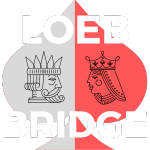On the auction below, what does North's 3♣ bid show?
- A competitive hand with long club like ♠72 ♥Q96 ♦93 ♣QJT762
- A forcing hand like ♠73 ♥965 ♦A9 ♣KQJT72
| South | West | North | East |
| 1NT | 2♠ | 3♣ |
 Opposite the competitive hand, South should pass. Opposite the forcing hand, South should bid 3NT with a hand like ♠A6 ♥KJ74 ♦KQ85 ♣A53.
Opposite the competitive hand, South should pass. Opposite the forcing hand, South should bid 3NT with a hand like ♠A6 ♥KJ74 ♦KQ85 ♣A53.
Guessing which hand North has can be costly. Both the competitive 3♣ bid and the game forcing 3♣ bid have legitimate bridge purposes. Sadly, there isn't enough room for natural bidding to allow responder to compete in clubs and to force in clubs. Since natural bidding will not suffice, you need a bid to act as a switch to allow responder to tell the 1NT opener whether they are competing or forcing.
The solution is to give up a natural 2NT response. An artificial 2NT bid is used as a switch to clarify the meaning of other auctions. Responder uses the artificial 2NT switch when they want to compete. Responder bypasses 2NT and bids their suit directly at the 3-level when they want to force to game. This agreement is called Lebensohl. It applies after a 1NT opening bid and a direct 2♦, 2♥, or 2♠ overcall. After a 2♣ overcall or a double, you have the room to play your normal responses to a 1NT opening. Use a double of a 2♣ overcall as Stayman (one of the few good uses of a "stolen bid" double).
When responder wants to compete in a suit lower than the overcall, they use the artificial 2NT response. This forces opener to rebid 3♣. Now responder can pass if they want to compete in clubs. If they want to compete in another suit, they bid the suit and opener knows it is competitive because it wasn't bid directly at the 3-level.
When responder wants to force to game, they bypass the artificial Lebensohl 2NT switch. Responder's direct bid of a suit at the 3-level is natural and game forcing.
| South | West | North | East |
| 1NT | 2♥ | ? |
Responder has more options when their suit is higher than the overcalled suit. On the auction to the right, responder has 4 ways to show a long spade suit. This allows responder to compete in spades, invite game with 5+ spades, force to game with 5+ spades, or bid game with 6+ spades.
- Bid 2♠ with a competitive hand like ♠KJ872 ♥96 ♦963 ♣Q62
- Jump to 3♠ to force to game with a hand like ♠KJ872 ♥96 ♦A63 ♣Q62
- Place the contract at 4♠ with 6+ spades and no slam interest, a hand like ♠KJ9872 ♥96 ♦A3 ♣Q62 (use a Texas Transfer if that is your agreement)
- To invite game with 5+ spades, responder uses the artificial Lebensohl 2NT switch which forces opener to rebid 3♣. Now responder bids 3♠ to show 5+ spades and invitational values. Responder is showing a hand like ♠KJ872 ♥96 ♦K63 ♣Q62
The Lebensohl 2NT switch can be used to differentiate game forcing hands with a stopper from game forcing hands without a stopper. Bidding 3NT directly shows game forcing values without a stopper. Using the artificial Lebensohl 2NT switch and then bidding 3NT shows game forcing values with a stopper.
| South | West | North | East |
| 1NT | 2♠ | 2NT* | Pass |
| 3♣* | Pass | 3NT |
| South | West | North | East |
| 1NT | 2♠ | 3NT |
The auction to the left shows game forcing values without a spade stopper. Opener will need to scramble to find a feasible strain if opener doesn't have a spade stopper. The auction to the right, going through the Lebensohl 2NT bid, and then bidding 3NT shows game forcing values with a spade stopper.
The same logic can be used to show or deny a stopper and look for a 4-4 major suit fit. Responder cue bids the overcalled suit directly to show game forcing values with a 4-card major and no stopper. Using the artificial Lebensohl 2NT switch and then rebidding cue bidding shows game forcing values, a 4-card major, and a stopper.
| South | West | North | East |
| 1NT | 2♠ | 2NT* | Pass |
| 3♣* | Pass | 3♠ |
| South | West | North | East |
| 1NT | 2♠ | 3♠ |
The auction to the left shows game forcing values, a 4-card heart suit, and denies a spade stopper. Opener will need to scramble if they don't have 4 hearts and don't have a spade stopper. The auction to the right, where the Lebensohl 2NT bid is used before cue bidding 3♠, shows game forcing values, a 4-card heart suit, and a spade stopper.
This agreement applies when partner opens 1NT and your right-hand-opponent overcall 2♦, 2♥. or 2♣. If right-hand-opponent overcalls a natural 2♣ (even if it shows clubs and another suit), it is best to play systems on. Use a double of 2♣ as Stayman. Other bids remain the same as your normal responses to 1NT.
A double of an overcall of 2♦ or higher is negative, meaning it is takeout oriented. The 1NT opener will typically convert the double for penalty with 4+ cards in the overcalled suit. So responder should have exactly a doubleton in the overcalled suit. To make a negative double, responder should have 3+ card support for the unbid suits and have enough strength to ensure their partnership has the majority of the HCP.
Click here for a video lesson on Lebensohl.




